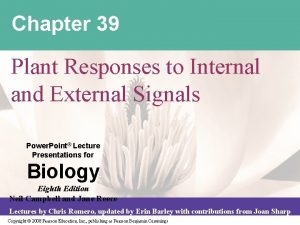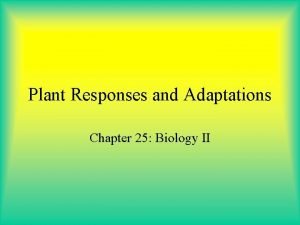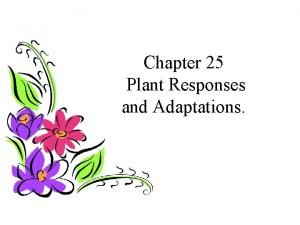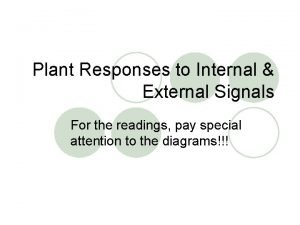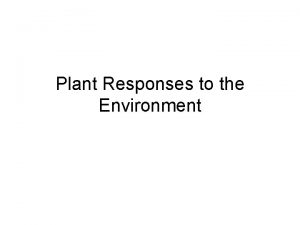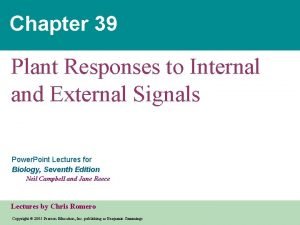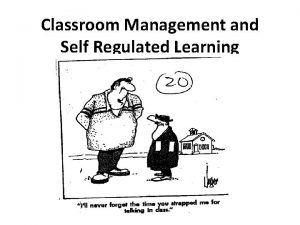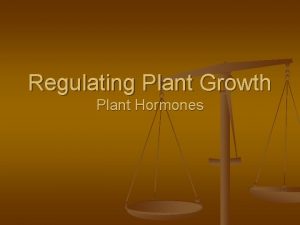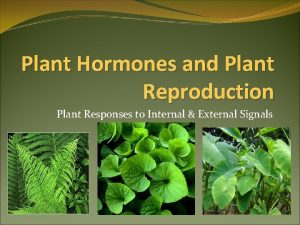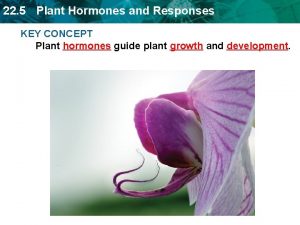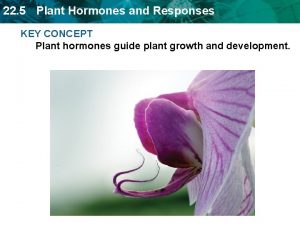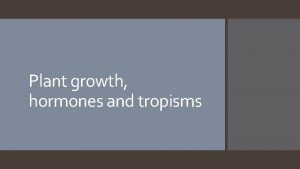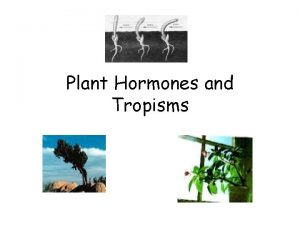22 5 Plant Hormones and Responses KEY CONCEPT












- Slides: 12

22. 5 Plant Hormones and Responses KEY CONCEPT Plant hormones guide plant growth and development.

22. 5 Plant Hormones and Responses Plant hormones regulate plant functions. • Hormones are chemical messengers. – produced in one part of an organism – stimulates or suppresses activity in another part

22. 5 Plant Hormones and Responses • Gibberellins are plant hormones that produce dramatic increases in size. – ending seed dormancy – Stimulates stem elongation, germination, and flowering

22. 5 Plant Hormones and Responses • Ethylene causes the ripening of fruits. – some fruits picked before they are ripe – sprayed with ethylene to ripen when reach destination

22. 5 Plant Hormones and Responses • Cytokinins stimulate cytokinesis. – final stage in cell division – produced in growing roots, seeds, and fruits – involved in growth of side branches

22. 5 Plant Hormones and Responses • Auxins lengthen plant cells in the growing tip. – stimulates growth of primary stem – controls some forms of tropism * A tropism is the movement of plant in response to an environmental stimulus. *

22. 5 Plant Hormones and Responses Plants can respond to light, touch, gravity, and seasonal changes. • Phototropism is the tendency of a plant to grow toward light. – auxins build up on shaded side of stem – cells on shaded side lengthen – causes stem to bend toward light

22. 5 Plant Hormones and Responses • Thigmotropism is a plant’s response to touch-like stimuli. – climbing plants and vines – plants that grow in direction of constant wind

22. 5 Plant Hormones and Responses • Gravitropism is a plant’s growth or turning in response to gravity. – positive gravitropism is downward growth (roots) – negative gravitropism is upward growth (shoots)

22. 5 Plant Hormones and Responses • Some plants have rapid responses not involving growth. – Some responses protect plants from predators. – Some responses allow plants to capture food. When leaves of a Venus Fly Trap are touched, water rushes to the cells in the bases of the leaf making it bend inward- - closing the “mouth” of the plant!

22. 5 Plant Hormones and Responses • Photoperiodism is a response to seasonal changes in day length. – triggers some plants to flower – triggers fall colors/winter dormancy of deciduous trees

22. 5 Plant Hormones and Responses Asexual Plant Propagation Lab • For this lab, you will be conducting plant propagation using a philodendron plant. • The first step in plant propagation from existing plants is to take cuttings. • Before making a cut, look for nodes—these are the beginnings of new leaves and stem systems and resemble small roots or buds. • After you have cutting, place the cutting in a cup with water reaching right below the leaf, but above the nodes. • Record your observations for day 1 (drawing and written description). • You will make weekly observations and drawings. At the end, you will construct a line graph to show your results.
 Plant hormones and responses
Plant hormones and responses Plant hormones and responses
Plant hormones and responses Chapter 25 plant responses and adaptations answer key
Chapter 25 plant responses and adaptations answer key Positive geotropism
Positive geotropism Plant responses to internal and external signals
Plant responses to internal and external signals The stationary life
The stationary life Seed germination
Seed germination Plant biology ppt
Plant biology ppt Plant
Plant Low key responses
Low key responses Chapter 4 lesson 4: metamorphic rocks answer key
Chapter 4 lesson 4: metamorphic rocks answer key Key concept builder lesson 1 what are waves answer key
Key concept builder lesson 1 what are waves answer key Tronsmo plant pathology and plant diseases download
Tronsmo plant pathology and plant diseases download

